About
Interview with Robert Gibbs
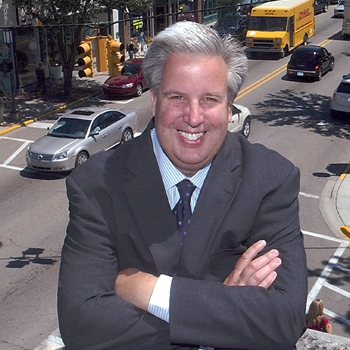 Robert Gibbs, ASLA / Gibbs Planning Group
Robert Gibbs, ASLA / Gibbs Planning Group
In 2017, retail e-commerce grew 16 percent to $453 billion, and it now accounts for 9 percent of all sales. Furthermore, 2/3 of millennials prefer online shopping to brick and mortar stores. What does this mean for the future of America’s retail streets, districts, and malls – for all those physical stores?
There’s going to be hundreds of stores closing. In 2018 already more stores have closed than in 2017. What this means for the industry: a lot of retailers are moving stores into downtowns.
Research shows millennials and other shoppers want the experience of being in an urban environment rather than just buying a pair of pants online. So mall closures are good for cities. You’re going to see retailers moving back into cities, and many Internet-based companies opening brick and mortar stores.
Warby Parker, an online eyeglass company, is opening physical stores, and Amazon’s opening two hundred bookstores in cities. Internet-based companies have found when they open a brick-and-mortar store, their online sales go up 10-15 percent.
One prediction is a quarter of existing malls will close in the next 5 years (some 300 out of the 1,100). Anchor stores – the big department stores – are closing hundreds of branches, while some 35 major retailers declared bankruptcy in 2017 alone. As many malls die off, what characteristics do the malls that are surviving, and even thriving, share?
About a fourth-to-a-half of malls will close in the next five to ten years.
The malls that are going to be sustainable -- after what I call post-mall period -- will be ones well-positioned, with really strong demographics -- either high-end demographics or strong middle-class demographics. They’ll have good locations with access to regional transportation.
Only malls that keep their department stores will survive. A mall cannot function without department stores. So when they lose all but one or all of their department stores, they have to close.
The other factor for successful malls is to be mixed use and incorporating residential, office, and civic space into their properties.
Just being a retail destination alone is not sustainable right now.
Transitioning to mixed use is not that hard to do because malls were built with more than twice the parking that is necessary by today’s standards. So, about half of the parking lots can be converted into other land uses.
The Grove in Los Angeles and 3rd Street Promenade in Santa Monica offer highly-stylized versions of urban forms – in the case of the Grove, an old European urban downtown, and 3rd Street Promenade, the American main street. Are successful contemporary shopping districts about re-using familiar urban forms in new ways?
Oh, very much so. The traditional grid or traditional straight main street is the best format for the new town centers being developed. There has been a lot of experimentation with curvilinear forms with parallel streets, and those haven’t worked too well. It has to be a simple main street.
We find the best shopping districts are only about a quarter of a mile long, about 1,200 feet. If you have a longer corridor, then we break it into sections. Where they come together, we anchor it with some form of civic or retail space. So, just the old fashioned street works the best, or with the very-slight deflection.
Some background on promenades, like the one on 3rd street in Santa Monica: In the 1960s and 70s, many downtowns declined and lost significant market share to large suburban shopping malls. In a well-intended response, over 250 downtowns imitated shopping centers and closed their main streets to vehicles in order to create outdoor pedestrian malls. Kalamazoo, Michigan, and Fresno, California, were pioneers in this experiment.
Unfortunately, all but ten of the pedestrian malls were a failure (the ones that survived are mostly in college towns). Most of the downtowns declined even further and remained almost entirely-vacant for decades. Even Santa Monica’s Third Street promenade and Miami Beach’s Lincoln Road were initially overwhelming failures. Without department stores, the pedestrian malls lacked the necessary critical mass of shopping to justify the inconvenience of parking in remote decks. Small retailers cannot afford much advertising and rely on drive-by impulse traffic for sales.
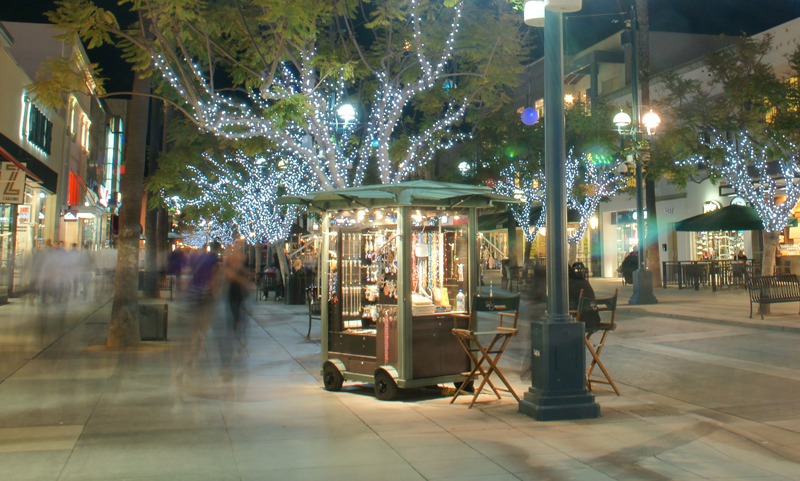 Third Street Promenade in Santa Monica, California / Wikipedia
Third Street Promenade in Santa Monica, California / Wikipedia
We have been advising several downtowns, including Fresno, to re-open their streets to cars with generous parallel parking. The key is to implement modern traffic-calming measures, an attractive public realm, and realistic codes to enable walkability and cross-shopping.
What are the core components of a successful retail district layout? How do you get density, inter-connectivity, and scale right? On the one hand, there is the model of Soho in NYC, with its grid layout, but you also have the standard outlet mall, defined by an arterial form.
A fairly straight or simple, deflected street works the best. It’s essential a retail district have multiple uses. All four land uses are best: commercial, office, civic, and residential. It’s also essential to have a good public realms in these centers and appropriate sidewalks for the type of transect that it is, whether it be a town or a city or hamlet. There has to be a good public space, such as a square or a plaza.
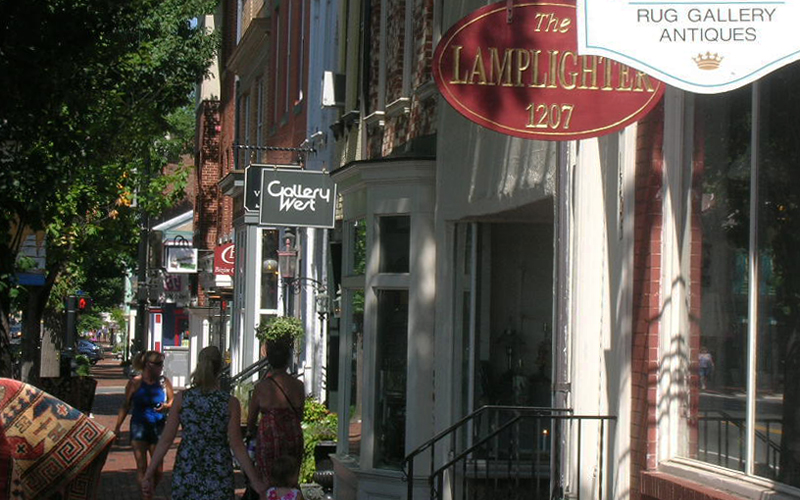 King Street in Old Town, Alexandria / Gibbs Planning Group
King Street in Old Town, Alexandria / Gibbs Planning Group
Retailers have higher sales and are willing to pay higher rents when they’re located on a square. We have found retailers who will give up exposure on the end caps of a street in exchange for being on the square, because that is where more people are and where they will achieve higher sales.
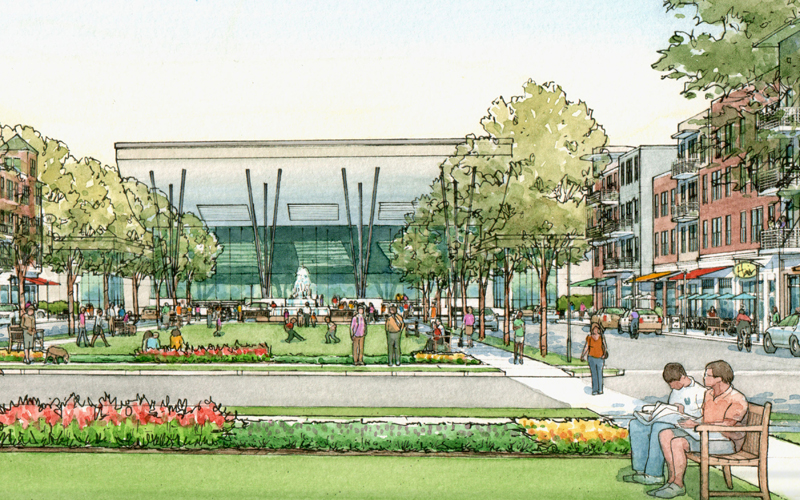 Troy, Michigan town center / Gibbs Planning Group
Troy, Michigan town center / Gibbs Planning Group
It's really important for landscape architects to embrace the public realm, to be strong advocates for parks and plazas, a nice streetscape.
Retail has been described as a tool for revitalizing small town main streets and the downtowns of major cities. What else needs to come with retail to make the revitalization effort work?
Retail alone can’t revitalize a downtown. One of the most important elements is transportation. Streets have to be calmed from highways into real, walkable streets. Many downtowns are suffering just for lack of on-street parking or because the streets are too wide and traffic is too fast.
In addition, it is important to have a strong civic component: the library, city hall, courthouses should be in the downtown, not in the suburbs. For example, we find a good library can bring an average of 1,200 people per day -- that's as many as a good department store.
High density residential and office space are important as well. The Urban Land Institute (ULI) recently did a study that found every office worker directly supports twenty-five square feet of retail and restaurant space. If we can get office workers downtown, you can share parking with the office, because of off-peak times with retail.
So downtowns have to return to being real mixed-use, urban, walkable centers.
What is the role of landscape architecture in successful retail environments?
The leaders of many shopping center developers we work with are landscape architects. Many of our clients are former landscape architects or practicing landscape architects.
More than the engineers,
architects or the MBA types, we find landscape architects have a
holistic approach, and we enjoy working with them. They understand the physical realm and design, but also politics, the environment, and a little bit of engineering and economics.
More broadly, the landscape architect working on a retail environment has to advocate for good place-making: a nice public realm -- public squares of plazas; traffic calming; and the right height-to-width ratios on the streets so streets aren’t too wide.
Do trees and other green features increase sales?
Trees are really essential for a competitive shopping district. There was a study by Kathleen Wolfe that indicated trees increase price elasticity by 9-12 percent. In other words, people feel comfortable paying up to twelve percent more for the same product if they purchase in a well-landscaped place with nice streets. Also, when properly located, street trees keep people in the downtown district longer. They feel more relaxed and are more likely to spend more money.
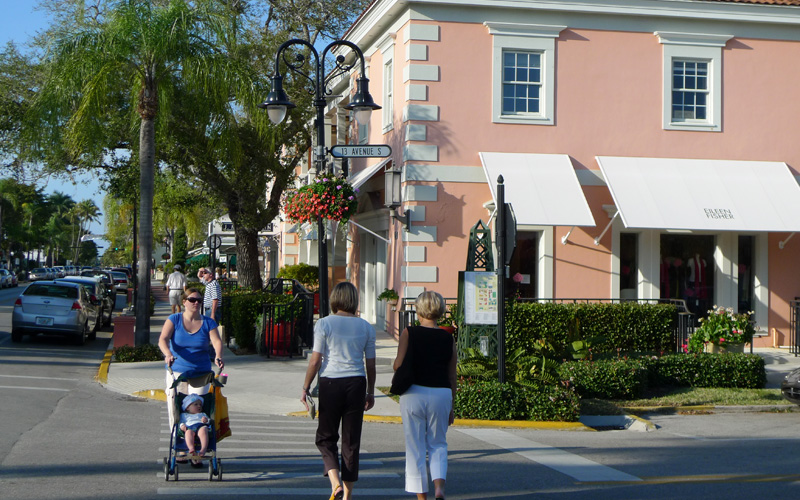 Relaxed shoppers in Naples, Florida / Gibbs Planning Group
Relaxed shoppers in Naples, Florida / Gibbs Planning Group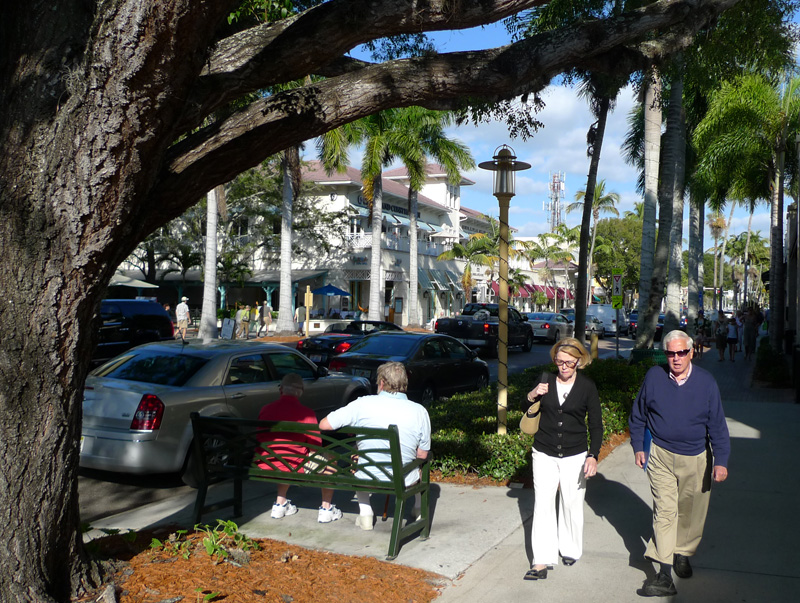 Relaxed shoppers in Naples, Florida / Gibbs Planning Group
Relaxed shoppers in Naples, Florida / Gibbs Planning Group
We’re working in Palm Desert, California, and found the shady side of the street has significantly higher sales and rents than the sunny side of the street. We're redesigning the street to be asymmetrical, so that the sunny side will have a wider sidewalk so that we can put in a triple bosque of trees for shade. In this case, the shade is directly responsible for higher sales in retail. Research indicates that, too.
The one pet peeve I have is that many landscape architects -- including myself, as I’ve done this -- tend to put street trees on an arbitrary grid, 22 feet or 28 feet on center, whatever. Very often the trees end up blocking a merchant's storefront, sign, or window display.
We believe developers and communities should put in a lot of street trees, but that you just use common sense when locating them. Street trees should be on the property lines of commercial buildings rather than in middle and in front of buildings.
Street trees are very important for retail sales, and that’s been proven. Also, for residential values, there are studies that indicate home values are much higher on shady streets than streets without trees.
Urban stores of retailers like Bonobo, Apple, and others are essentially show-rooms, where you try out goods and then purchase online and receive products by mail. What other technology-enabled retail innovations do you see coming to the built environment?
Technology has been good and bad. One negative is many online manufacturers are selling directly to the customers, and they are not sending merchandise to small retailers. They’re cutting the retailer out of the better merchandise, which is hurting their sales.
A positive is many stores are getting rid of cash registers so you can walk in and out.
Another positive: Store are becoming warehouse and distribution centers. Department stores are now places where you can do a same-day pick-up of an order you made online. Physical stores are becoming return centers for Amazon and other online sites. For example, Kohl's is partnering with Amazon to be a return center. This helps bring people to that shopping district who ordinarily wouldn't go there. They’re going to make a return and then while they are making their return, they will go to restaurants or other shops.
Robert Gibbs, ASLA, is president of the Gibbs Planning Group, which has advised and planned commercial areas in some 500 town centers and historic cities in the U.S. and abroad. Gibbs is a charter member of the Congress for New Urbanism, a lecturer at the Harvard University Graduate School of Design, author of Principles of Urban Retail Planning and Development, and co-author of eight books.